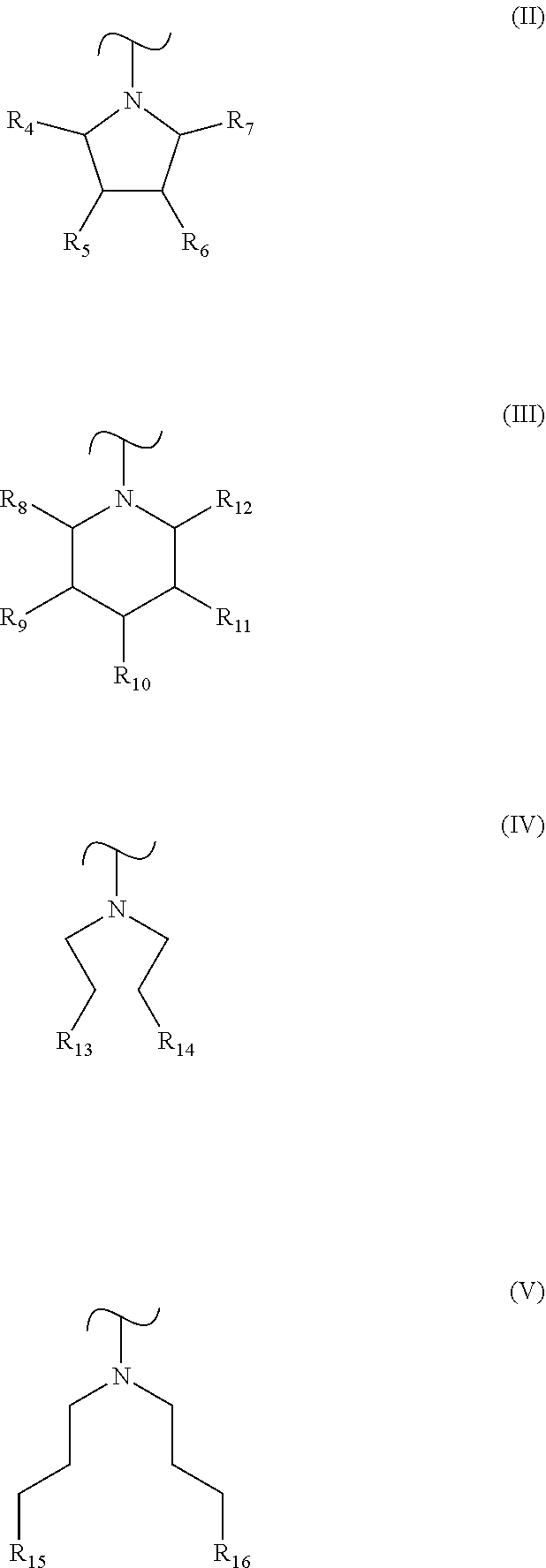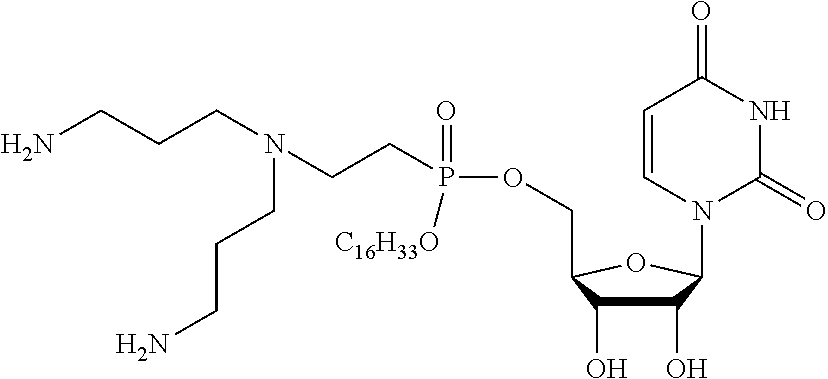Lipophosphonoxins of second generation, and their use
a technology of lipophosphonoxin and phosphonoxin, which is applied in the direction of biocide, sugar derivatives, plant growth regulators, etc., can solve the problems of bacteria not being able to develop resistance, and achieve the effect of strong antibacterial activity and easy preparation
- Summary
- Abstract
- Description
- Claims
- Application Information
AI Technical Summary
Benefits of technology
Problems solved by technology
Method used
Image
Examples
example 1
Hexadecyl-uridine-5′-yl-2-N-bis (3-aminopropyl)-2-aminoethyl phosphonate
[0051]
[0052]A mixture of bis boc-N-1-(3-aminopropyl)propane-1,3-diamine (0.53 g, 1.5 mmol) (prepared according to J. Med. Chem. 2014, 57 (22), 9409-9423) and hexadecyl-2′,3′-isopropylidenuridin-5′-yl-vinylphosphonate (0.6 g, 1 mmol) (prepared according to J. Med. Chem. 2011, 54(22), 7884-7898) in n-BuOH (10 ml) was stirred overnight at 105° C. The reaction mixture was concentrated in vacuum and the isopropylidene-protected intermediate was purified by chromatography on silica gel using a linear gradient of ethanol in chloroform (0-10%). The resulting solid was dissolved in 0.5 mol·l−1 HCl in methanol (40 ml) and the mixture was stirred for 12 hours at room temperature. The reaction mixture was concentrated to about half volume on rotary evaporator and added to cold ethyl acetate (20 ml). The solid obtained was filtered and dried. This resulted in the desired product as an amorphous solid in 74% yield (0.56 g, 0....
example 2
Pentadecyl-uridine-5′-yl-2-N-bis(3-aminopropyl)-2-aminoethyl phosphonate
[0057]
[0058]The compound in Example 2 was prepared by the same procedure as the one in Example 1 from bis boc-N-1-(3-aminopropyl)propane-1,3-diamine (0.53 g, 1.5 mmol) and pentadecyl-2′,3′-isopropylidenuridine-5′-yl-vinylphosphonate (prepared according to J. Med. Chem. 2011, 54(22), 7884-7898) (0.63 g, 1 mmol) in 75% yield (0.56 g, 0.75 mmol).
[0059]1H NMR (500.0 MHz, CD3OD): 0.90 (m, 6H, CH3(CH2)13CH2O-A,B); 1.24-1.43 (m, 48H, CH3(CH2)12CH2CH2O-A,B); 1.71 (m, 4H, CH3(CH2)12CH2CH2O-A,B); 2.15-2.23 (bm, 8H, NCH2CH2CH2NH2-A,B); 2.52-2.62 (m, 4H, PCH2CH2N-A,B); 3.09 (t, 8H, Jvic=7.5, NCH2CH2CH2NH2); 3.32-3.42 (bm, 8H, NCH2CH2CH2NH2); 3.43-3.51 (bm, 4H, PCH2CH2N); 4.11-4.20 (m, 8H, H-3′,4′-A,B, CH3(CH2)13CH2O-A,B); 4.26 (dd, 1H, =5.3, J2′,1′=4.1, H-2′-A); 4.28 (dd, 1H, J2′,3′=5,1, J2′,1′=3.9, H-2′-B); 4.30-4.45 (m, 4H, H-5′-A,B); 5.764 (d, 1H, J5,6=8.0, H-5-A); 5.766 (d, 1H, J5,6=8.0, H-5-B); 5.83 (d, 1H, J1′,2′=4.1,...
example 3
Tetradecyl-uridine-5′-yl-2-N-bis (3-aminopropyl)-2-aminoethyl phosphonate
[0063]
[0064]The compound in Example 3 was prepared by the same procedure as the one in Example 1 from boc-N-1-(3-aminopropyl)propane-1,3-diamine (0.62 g, 1.86 mmol) and tetradecyl-2′,3′-isopropylidenuridine-5′-yl-vinylphosphonate (prepared according to J. Med. Chem. 2011, 54(22), 7884-7898) (0.76 g, 1.33 mmol) in 65% yield (0.64 g, 0.87 mmol).
[0065]1H NMR (500.0 MHz, CD3OD): 0.90 (m, 6H, CH3(CH2)12CH2O-A,B); 1.24-1.43 (m, 44H, CH3(CH2)11CH2CH2O-A,B); 1.71 (m, 4H, CH3(CH2)12CH2CH2O-A,B); 2.16-2.26 (bm, 8H, NCH2CH2CH2NH2-A,B); 2.54-2.65 (m, 4H, PCH2CH2N-A,B); 3.10 (t, 8H, J Jvic=7.5, NCH2CH2CH2NH2); 3.35-3.42 (bm, 8H, NCH2CH2CH2NH2); 3.44-3.52 (bm, 4H, PCH2CH2N); 4.08-4.22 (m, 8H, H-3′,4′-A,B, CH3(CH2)12CH2O-A,B); 4.27 (dd, 1H, J2′,3′=5.4, J2′,1′=4.2, H-2′-B); 4.28 (dd, 1H, J2′,3′=5.3, J2′,1′=3.9, H-2′-A); 4.34 (ddd, 1H, Jgem=11.5, JH,P=7.4, J5′b,4′=5.4, H-5′b-B); 4.39 (dd, 2H, JH,P=7.6, J5′,4′=4.2, H-5′-A); 4.43...
PUM
| Property | Measurement | Unit |
|---|---|---|
| concentration | aaaaa | aaaaa |
| resistance | aaaaa | aaaaa |
| pH | aaaaa | aaaaa |
Abstract
Description
Claims
Application Information
 Login to View More
Login to View More - R&D
- Intellectual Property
- Life Sciences
- Materials
- Tech Scout
- Unparalleled Data Quality
- Higher Quality Content
- 60% Fewer Hallucinations
Browse by: Latest US Patents, China's latest patents, Technical Efficacy Thesaurus, Application Domain, Technology Topic, Popular Technical Reports.
© 2025 PatSnap. All rights reserved.Legal|Privacy policy|Modern Slavery Act Transparency Statement|Sitemap|About US| Contact US: help@patsnap.com



